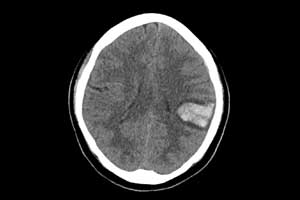- Home
- Editorial
- News
- Practice Guidelines
- Anesthesiology Guidelines
- Cancer Guidelines
- Cardiac Sciences Guidelines
- Critical Care Guidelines
- Dentistry Guidelines
- Dermatology Guidelines
- Diabetes and Endo Guidelines
- Diagnostics Guidelines
- ENT Guidelines
- Featured Practice Guidelines
- Gastroenterology Guidelines
- Geriatrics Guidelines
- Medicine Guidelines
- Nephrology Guidelines
- Neurosciences Guidelines
- Obs and Gynae Guidelines
- Ophthalmology Guidelines
- Orthopaedics Guidelines
- Paediatrics Guidelines
- Psychiatry Guidelines
- Pulmonology Guidelines
- Radiology Guidelines
- Surgery Guidelines
- Urology Guidelines
CT black hole sign accurately predicts hematoma expansion in ICH

Computed tomography (CT) black hole sign is the most accurate predictor of hematoma expansion (HE) in patients with intracerebral hemorrhage (ICH) as compared to other CT features, according to a study published in the Journal of Neurology. However, it was not an independent predictor of poor outcome.
Xiong Han, Department of Neurology, Henan Provincial People’s Hospital, Zhengzhou, China, and colleagues conducted the study to compare the black hole sign with other CT features to predict the HE and the outcome in patients with intracerebral hemorrhage.
Intracerebral hemorrhage is focal bleeding from a blood vessel in the brain parenchyma. The cause is usually hypertension. Typical symptoms include focal neurologic deficits, often with abrupt onset of a headache, nausea, and impairment of consciousness. Diagnosis is by CT or MRI. The hematoma expansion (HE) is an important risk factor for early neurological deterioration and poor prognosis.
For the study, patients were enrolled within 12 h after stroke attack in the emergency department of Henan Provincial People’s Hospital between January 2012 and June 2016. The clinical characters and CT features including the initial CT and the follow-up CT within 48 h were recorded. The outcome was assessed by using the modified Rankin Scale on discharge. Logistic regression analyses were used to investigate whether the factors were the independent predictor of HE and the outcome in patients with ICH. The sensitivity, specificity, positive predictive value, and negative predictive of CT features in predicting HE were calculated.
A total of 185 ICH patients were enrolled, including 70 (37.8%) patients in HE group and 115 (62.2%) patients in the non-HE group.
Results:
- There were a significant difference in the initial hematoma volume, irregular shape, and CT black hole sign between the two groups.
- While the irregular shape and CT black hole sign were independent predictors for HE, the sensitivity and specificity were 71.45 and 54.78, 51.4 and 81.7%, respectively.
- Multivariable analysis identified CT black hole sign and initial intraventricular hemorrhage expansion were not the independent predictors of poor outcome.

Disclaimer: This site is primarily intended for healthcare professionals. Any content/information on this website does not replace the advice of medical and/or health professionals and should not be construed as medical/diagnostic advice/endorsement or prescription. Use of this site is subject to our terms of use, privacy policy, advertisement policy. © 2020 Minerva Medical Treatment Pvt Ltd